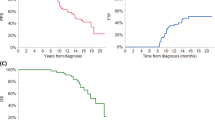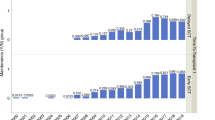Abstract
The response evaluation after autologous stem-cell transplantation (ASCT) is usually performed at day +100 in patients with multiple myeloma (MM). A recent report suggests that improvement in the response can be observed beyond day +100. The aim of the present study has been to evaluate the rate of improved response and outcome beyond day +100 after ASCT, with and without maintenance therapy. One hundred and forty-four patients who underwent single ASCT with chemosensitive disease and achieved less than CR at day 100 post ASCT were evaluated. Seventy-four patients (51.4%) did not receive any maintenance with only one of them showing an upgrade in the response. The remaining 70 patients (48.6%) received maintenance therapy; eleven of them (15.7%) improved their response beyond day +100. The outcome of these patients was better than those who did not upgrade their response in both progression-free survival and overall survival (P=0.019 and P=0.031, respectively). In conclusion, the improvement in response beyond day +100 after ASCT in patients not receiving any therapy is exceedingly rare. A minority of patients receiving maintenance therapy after ASCT upgrades their response and this finding is associated with better outcome.
This is a preview of subscription content, access via your institution
Access options
Subscribe to this journal
Receive 12 print issues and online access
$259.00 per year
only $21.58 per issue
Buy this article
- Purchase on Springer Link
- Instant access to full article PDF
Prices may be subject to local taxes which are calculated during checkout


Similar content being viewed by others
References
Bladé J, Rosiñol L, Cibeira MT, Rovira M, Carreras E . Hematopoietic stem cell transplantation for multiple myeloma beyond 2010. Blood 2010; 115: 3655–3663.
San-Miguel JF, Mateos MV . Can multiple myeloma become a curable disease? Haematologica 2011; 96: 1246–1248.
Kyle RA, Rajkumar SV . Criteria for diagnosis, staging, risk stratification and response assessment of multiple myeloma. Leukemia 2009; 23: 3–9.
Fernández de Larrea C, Jiménez R, Rosiñol L, Giné E, Tovar N, Cibeira MT et al. Pattern of relapse and progression after autologous SCT as upfront treatment for multiple myeloma. Bone Marrow Transplant 2014; 49: 223–227.
Martinez-Lopez J, Blade J, Mateos MV, Grande C, Alegre A, García-Laraña J et al. Long-term prognostic significance of response in multiple myeloma after stem cell transplantation. Blood 2011; 118: 529–534.
Gonsalves WI, Gertz MA, Dispenzieri A, Lacy MQ, Lin Y, Singh PP et al. Implications of continued response after autologous stem cell transplantation for multiple myeloma. Blood 2013; 122: 1746–1749.
Bladé J, Samson D, Reece D, Apperley J, Björkstrand B, Gahrton G et al. Criteria for evaluating disease response and progression in patients with multiple myeloma treated by high-dose therapy and haemopoietic stem cell transplantation. Br J Haematol 1998; 102: 1115–1123.
Durie BG, Harousseau JL, Miguel JS, Bladé J, Barlogie B, Anderson K et al. International uniform response criteria for multiple myeloma. Leukemia 2006; 20: 1467–1473.
Paiva B, Vidriales MB, Cerveró J, Mateo G, Pérez JJ, Montalbán MA et al. Multiparameter flow cytometric remission is the most relevant prognostic factor for multiple myeloma patients who undergo autologous stem cell transplantation. Blood 2008; 112: 4017–4023.
Rawstron AC, Gregory WM, de Tute RM, Davies FE, Bell SE, Drayson MT et al. Minimal residual disease in myeloma by flow cytometry: independent prediction of survival benefit per log reduction. Blood 2015; 125: 1932–1935.
Ladetto M, Ferrero S, Drandi D, Festuccia M, Patriarca F, Mordini N et al. Prospective molecular monitoring of minimal residual disease after non-myeloablative allografting in newly diagnosed multiple myeloma. Leukemia 2015; 30: 1211–1214.
Martinez-Lopez J, Lahuerta JJ, Pepin F, González M, Barrio S, Ayala R et al. Prognostic value of deep sequencing method for minimal residual disease detection in multiple myeloma. Blood 2014; 123: 3073–3079.
Zamagni E, Patriarca F, Nanni C, Zannetti B, Englaro E, Pezzi A et al. Prognostic relevance of 18-F FDG PET/CT in newly diagnosed multiple myeloma patients treated with up-front autologous transplantation. Blood 2011; 118: 5989–5995.
Wang W, Wang EQ, Balthasar JP . Monoclonal antibody pharmacokinetics and pharmacodynamics. Clin Pharmacol Ther 2008; 84: 548–558.
Attal M, Lauwers-Cances V, Marit G, Caillot D, Moreau P, Facon T et al. Lenalidomide maintenance after stem-cell transplantation for multiple myeloma. N Engl J Med 2012; 366: 1782–1791.
McCarthy PL, Owzar K, Hofmeister CC, Hurd DD, Hassoun H, Richardson PG et al. Lenalidomide after stem-cell transplantation for multiple myeloma. N Engl J Med 2012; 366: 1770–1781.
Palumbo A, Hajek R, Delforge M, Kropff M, Petrucci MT, Catalano J et al. Continuous lenalidomide treatment for newly diagnosed multiple myeloma. N Engl J Med 2012; 366: 1759–1769.
Bladé J, San Miguel JF, Escudero ML, Fontanillas M, Besalduch J, Gardella S et al. Maintenance treatment with interferon alpha-2b in multiple myeloma: a prospective randomized study from PETHEMA. Leukemia 1998; 12: 1144–1148.
Björkstrand B, Svensson H, Goldschmidt H, Ljungman P, Apperley J, Mandelli F et al. Alpha-interferon maintenance treatment is associated with improved survival after high-dose treatment and autologous stem cell transplantation in patients with multiple myeloma: a retrospective registry study from the European Group for Blood and Marrow Transplantation. Bone Marrow Transplant 2001; 27: 511–515.
Ferrero S, Ladetto M, Drandi D, Cavallo F, Genuardi E, Urbano M et al. Long-term results of the GIMEMA VEL-03-096 trial in MM patients receiving VTD consolidation after ASCT: MRD kinetics' impact on survival. Leukemia 2015; 29: 689–695.
Acknowledgements
We thank Esther Bladé for her technical support in this research. This work has been supported in part by grants RD12/0036/0046, PI12/1093 and PI16/0423 from Instituto de Salud Carlos III and Fondo Europeo de Desarrollo Regional (FEDER), and 2014SGR-552 from AGAUR (Generalitat de Catalunya).
Author contributions
CFL, JD and EO designed the study, collected and analyzed the data, performed statistical analysis, wrote and reviewed the paper; II, LR, RGS, MTC, NT, MR, MVM, JSM and JB treated the patients, collected the data and reviewed the paper. All the authors approved the final version.
Author information
Authors and Affiliations
Corresponding author
Ethics declarations
Competing interests
The authors declare no conflict of interest.
Rights and permissions
About this article
Cite this article
Fernández de Larrea, C., Dávila, J., Isola, I. et al. Absence of spontaneous response improvement beyond day +100 after autologous stem cell transplantation in multiple myeloma. Bone Marrow Transplant 52, 567–569 (2017). https://doi.org/10.1038/bmt.2016.299
Received:
Revised:
Accepted:
Published:
Issue Date:
DOI: https://doi.org/10.1038/bmt.2016.299



